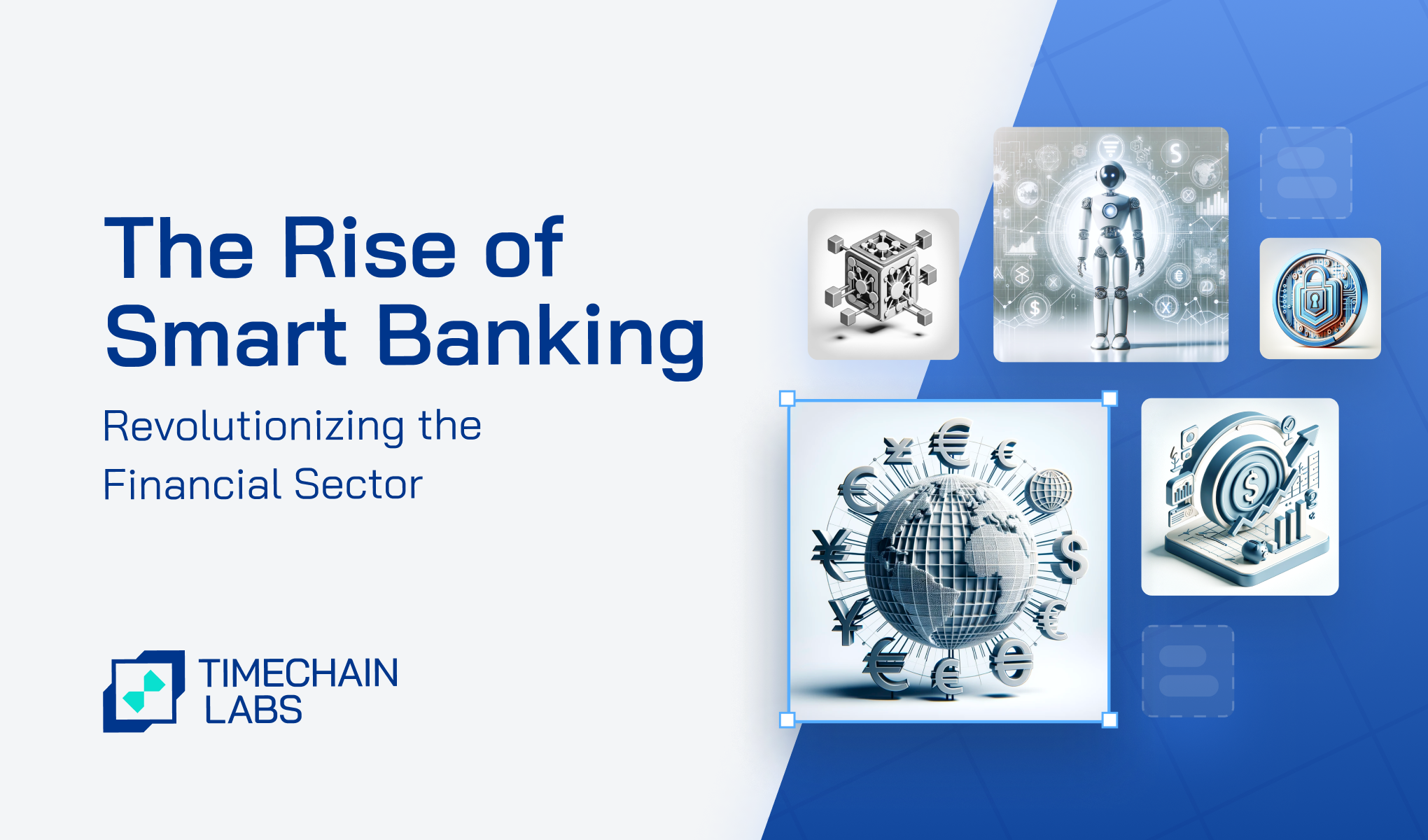The finance industry is actively keeping pace with the widespread trend of harnessing technology to elevate services. Traditional banking is undergoing a transformative shift to enrich customer experiences and streamline operations. As a result, the concept of smart banking is gaining much prominence.
The global market size for smart banking is estimated to account for up to $678.4 million by 2027. The widespread adoption of mobile banking services is the key factor behind driving this anticipated growth. This blog will shed light on how blockchain-backed smart banking is advancing financial services.
What is Smart Banking?
Smart banking incorporates advanced technologies and digital solutions into traditional banking processes. It enhances efficiency, provides personalized services, and improves overall customer experience. Smart banking leverages technologies such as artificial intelligence, data analytics, blockchain, and mobile applications.
The adoption of smart banking has become indispensable as the global digital banking user base is projected to reach around 3.6 billion by 2024.
Role of Ledger as a Service in the Smart Banking
Ledger as a Service involves outsourcing the management of distributed ledgers or blockchain technology to a third-party service provider. Here are the key benefits it offers for the finance segment:
- Shared Ledger Technology (SLT): LaaS is built on Shared ledger technology called blockchain. It is a distributed and tamper-resistant ledger that records transactions across a network of computers.
- Unsurpassable Security: Cryptographic techniques and consensus mechanisms are employed by the LaaS. The decentralized nature of the ledger ensures that no single entity controls the entire system. It reduces the risk of fraud and unauthorized access.
- Transparency and Accountability: Through a distributed ledger, all participants in the network can have real-time access to the same information for an accountable system. This transparency is crucial in gaining the trust of customers and stakeholders.
- Smart Contracts: LaaS often supports the implementation of smart contracts. These are self-executing contracts with the terms directly written into code. Smart contracts automate and enforce the terms of an agreement, reducing the need for intermediaries. It expedites various financial processes, such as Know Your Customer (KYC), automated payments, loan approvals, and settlements.
- Asset Representation with Tokens: LaaS allows financial institutions to represent real-world assets, like real estate, stocks, digital currencies or commodities, as digital tokens on the distributed ledger. Each token corresponds to a specific fraction or whole unit of the underlying asset.
- Cross-Border Transactions: Transactions on a blockchain network can occur in real time, reducing delays associated with traditional banking systems.
- Financial Inclusion: Blockchain's accessibility allowsdecentralized finance (DeFi) solutions to be created. It promotes financial inclusion by providing services to unbanked or underbanked individuals.
- Cost-Effective Solution: LaaS allows financial institutions to access the benefits of distributed ledger technology without requiring extensive in-house development and maintenance.
Banks are leveraging blockchain technology across various domains, with the highest application in international money transfers at 60%. Securities clearing and settlement follow at 23%, and KYC (Know Your Customer) and AML (Anti-Money Laundering) measures at 20%. Blockchain's role in fiat currency payment and settlement, as well as enhancing transparency, both capture a 19% utilization rate. Decentralized notary services account for 16%, while its use as a fraud deterrent is at 15%. Asset registries and security issuance and transfer applications are at 12% and 11% respectively.
What are the Key Features of Smart Banking?
Smart Banking utilizes digital technologies to transform traditional banking services into streamlined, automated processes. From account opening to transaction monitoring, it increases efficiency, reduces costs, and facilitates a seamless customer journey. Here are the core features it offers:
- Data Analytics and Artificial Intelligence: Advanced analytics and artificial intelligence are employed to analyze vast amounts of customer data. It lets banks gain valuable insights into user behavior, preferences, and financial patterns for personalized services and targeted product recommendations.
- Mobile Banking: The ubiquity of smartphones has given rise to mobile banking, a cornerstone of Smart Banking. Customers can perform a myriad of transactions, from fund transfers to bill payments, using dedicated mobile banking apps. This also enables real-time access to financial information. Over 89% of bank account holders located in the US rely on mobile banking.
- Chatbots and Virtual Assistants: Customer service is revolutionized by integrating chatbots and virtual assistants. These AI-powered entities handle routine queries, provide account information, and assist customers in real time. According to experts, chatbot usage will lead to savings of up to $7.3 billion in customer support expenditures for the banking industry.
- Biometric Authentication: Smart Banking places a strong emphasis on security. Thus, biometric authentication methods, such as fingerprint or facial recognition, are becoming crucial. It ensures that only authorized individuals can access sensitive financial information, adding an extra layer of protection.
How Timechain’s Solutions are Taking the Standard Smart Banking Solutions a Notch Higher
Timechain's programmable wrapper simplifies CBDC integration, empowering commercial banks with easy access to CBDC possibilities. The platform facilitates deposit token issuance, offering digital asset choices. Built on an L1 blockchain, Timechain uses low-code/no-code tools for programmable tokens and smart contracts.
It seamlessly integrates with CBDC and UPI rails for domestic intra-bank settlements. Timechain presents a blockchain-enabled CBDC forex market for intermediary and wholesale banks, aiming for top-tier liquidity exchange rates and swift fund tracking for accelerated transactions.
Experience the future of smart banking, uplifted by Timechain’s innovative solutions. Book a demo today!
References
https://www.enterpriseappstoday.com/stats/digital-banking-statistics.html
https://changelly.com/blog/wp-content/uploads/2021/12/ban-2-1536x1047.webp
https://changelly.com/blog/blockchain-in-banking/
https://datamyte.com/blog/smart-banking/
https://www.marketsandmarkets.com/Market-Reports/smart-banking-market-219362842.html
https://drive.google.com/file/d/1FsvyLRLTPnuDUyJbXIzl0XuLIZYTRmUG/view
